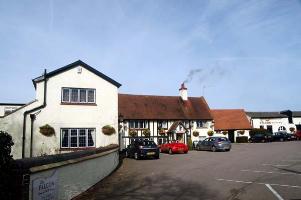Bletsoe Mills

The Falcon Public House, site of Bletsoe Mills (taken in March 2007)
The earliest mention of Bletsoe Mill is in the Domesday Book of 1086 when Hugh de Beauchamp and Countess Judith each owned a half share in it. The next record of a mill at Bletsoe is recorded in Volume XLI of Bedfordshire Historical Records Society - a book of coroner's rolls for medieval Bedfordshire translated by R. F. Hunnisett, entry 196 reads: "On 24 March [1273] Stephen son of William le Caretter of Snelson and William son of Ralph of Radwell boarded a boat, intending to cross the river Ouse to Sir Simon of Pattishall's mill at Bletsoe, and by the strength of the wind the boat was overturned and Stephen and William fell into the river and drowned by misadventure. Stephen's mother Isabel of Turvey searched for her son daily by the river and on 27 March found him drowned…"
The next substantial mention is in 1611 when the miller, William Wherbye drew up his will [ABP/W1611-12/144] which was proved on 7 March 1612; a probate inventory notes a parlour, hall, kitchen, parlour chamber, hall chamber, kitchen chamber buttery and millhouse, mill and yard, and includes the following entries [note the eccentric spelling]:
In the Butery & Millhouse
Tow
hoghsedes & 4 barrells;a powdermill Tobb, four [illegible], 3 boules, a cherne;a cheespresse, 12 cheespatts, 5 Tobbs, a fatt & Shelves
In the Mill
- a bedd of borde, a flockbedd, a boulster, 2 blancketts and a covering;3 coffers for corne, a bushell, a peck, a halfpeck and a boulting & peck;2 Iron barrs, a feidg [?], 12 milbills, a lonng hand sawe and 2 short hand sawes & 4 Augers for a cafnett [?]
In a survey of Bletsoe Manor of 1624 [WG10] Thomas Aspland had two corn mills and a wheat mill (i.e. three sets of mill stones) "with sufficiente howse adioyninge under one roofe and the fishinge and profits of the river of Ouse extendinge and goinge in lengths so farr foorth as the dams and his backe waters above the myll's Northwarde and below the mylls as the Orchyarde or Close corner".
The next mention of the mill comes in about 1650 [J280] when a four year lease of Bletsoe Mills is noted as being worth £20. It is known that the Falcon public house stands on the site of a mill and is first mentioned in 1757 when the Lieutenancy meetings were held there. When the Falcon was listed by the former Department of Environment in August 1987 it was dated as 16th or 17th century. If the former date is correct it suggests that the falcon incorporates some of the old mill building or buildings.
However, it seems as if there was more than one mill in the parish as there is documentary evidence of at least one, possibly two others. Lord Saint John, Lord of the Manor, certainly owned a mill and it looks, at first sight, as though another belonged to the Duke of Bedford because a survey on 8th March 1815 [R4/608/18/19] by the Duke's surveyor survives and notes as follows:
"On a cursory Survey of these Premises it appears that the whole of the Dwelling House Mill Buildings and Machinery therein are completely worn out and ruinous so that a repair of them is not adviseable. In the case of Rebuilding them considerable alteration is required for the better arranging of the Mill House and Machinery which can only be done by a regular Survey & Plan and in any new plan it is adviseable entirely to detach the Water Wheel or Wheels from the Flood Gates".
"The Flood Gates appear also completely worn out and with them Frames require renewing".
"The Outfall is in a ruinous state and is much too narrow - and without securing and repairing it there is much danger of a heavy Breach in the Bank".
"The Bank between the Mill and the Outfall is in a neglected bad state and being so low the frequent flow of water renders any small making good of the Ground very ineffective - to do it properly it should be so raised that no ordinary flush of water should run over it and Heavy Cattle should be kept off the Bank would then become sound and Grass over and then no extraordinary flood would affect it".
"To put all these works in a substantial state will be a heavy work. In the Machinery and for the Flood Gates Cast iron may be introduced with advantage tho in point of fact not with Economy and the Expense generally is computed at not less than Three Thousand Pounds".
About a year later Lord St.John wrote to an unnamed person [Li/Lib1/19/7/75] "The Works at my Mill at Bletsoe are now so advanced as to enable you to form some Judgement with regard to them; whenever therefore it will suit you to look at them I shall have much pleasure in meeting you any day after Friday next".
What at first sight looks like two mills may possibly be just one, as it is quite likely that the Duke's surveyor was making a speculative survey because the Duke intended to buy and perhaps came to an arrangement with Lord Saint John that he would buy only if the mill was repaired.
The final document which may refer to the mill is an apprenticeship indenture of John Randall, with consent of his uncle Richard of Marston Moretaine, farmer, bound to Daniel Hipwell of Bletsoe, miller for five years from 24 Jun 1822 [Z881/1]. Daniel Hipwell, who lived in Bletsoe, was the miller at Stoke Mills at Sharnbrook, although it is possible that he had also acquired the tenancy of the mill in Bletsoe.